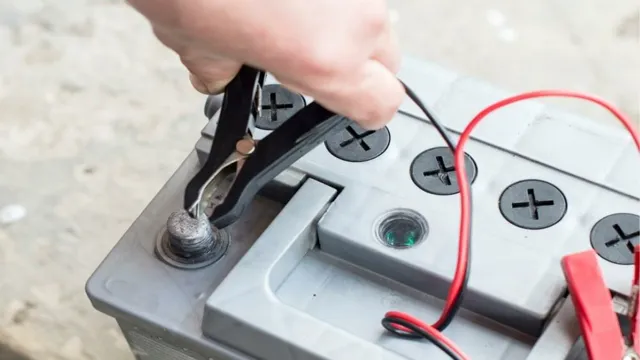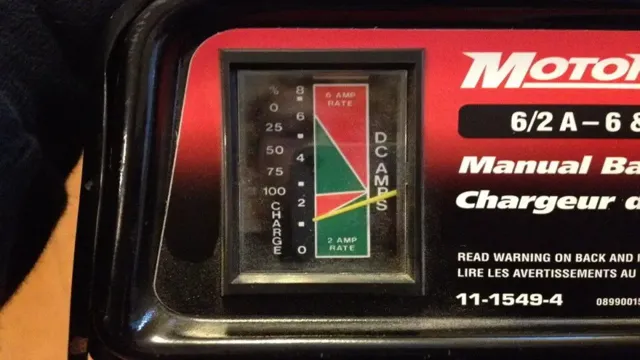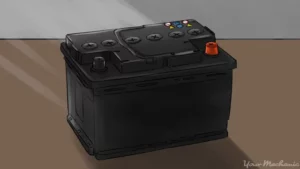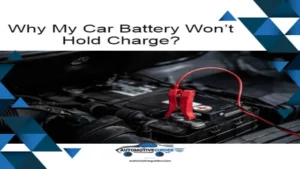Have you ever come across an old car battery charger and wondered how to decipher its readings and specifications? Fear not, as learning how to read an old car battery charger is a useful skill for any car owner or mechanic. Navigating the various dials, switches, and numbers on an old charger can be overwhelming at first, but with a little guidance, you can effectively use this valuable tool to keep your car battery in top shape. By understanding the charger’s capacity, output voltage, and amperage rating, you can determine the appropriate charging time and power level for your battery.
In this blog post, we’ll break down everything you need to know about reading an old car battery charger. We’ll cover the basics of charger components, demystify the various settings and indicators, and provide tips for optimal charging. By the end of this post, you’ll feel confident in your ability to use an old car battery charger effectively, extending the life of your battery and saving you money in the long run.
So let’s get started and unlock the secrets of the old car battery charger!
Introduction
If you’ve got an old car battery charger lying around, it’s worth knowing how to read it. These chargers come with a variety of settings, and figuring out the right one can be a bit tricky if you don’t know what you’re doing. The first thing to look for is the amperage rating, which will be printed on the charger itself.
This tells you how much current the charger can provide, and you’ll need to make sure it’s compatible with your battery. You’ll also want to look for the voltage rating, as well as any special settings that might be available (such as a “boost” mode for jumpstarting a dead battery). Once you’ve got a handle on these basics, you’ll be able to confidently make use of your old car battery charger whenever you need it.
Explaining the Importance of Reading Car Battery Chargers
Car battery chargers are crucial for maintaining the performance of your car’s battery. A car battery charger is a device that charges your car battery using electrical power from another source. It is important to understand how to read car battery chargers to ensure you are using the right settings and are aware of any potential issues.
Reading the charging voltage, current, and charge status can help you identify any problems and diagnose any potential issues with the battery, allowing you to take preventative measures before your battery dies. Remember, a dead battery can leave you stranded and in desperate need of a jump-start. By understanding how to use a car battery charger, you can prolong the life of your battery and ensure your car is always ready for those long drives.

Types of Old Car Battery Chargers
Old car battery chargers come in various types, each with its own set of benefits and limitations. Choosing the right one can be a daunting task, especially if you have no prior knowledge about them. Some of the commonly available types of old car battery chargers include trickle, automatic, manual, and multi-stage chargers.
Trickle chargers are perfect for maintaining a battery’s overall charge, while automatic chargers add charging capability along with monitoring and automation features. Manual chargers require the user to adjust the charging process manually, whereas multi-stage chargers provide a more advanced charging process and are generally faster and more efficient than other types. Whatever type of old car battery charger you choose, make sure that it suits your specific needs and requirements.
Reading an Old Car Battery Charger
If you’ve stumbled upon an old car battery charger and aren’t quite sure how to read it, don’t worry – we’ve got you covered. First, take a look at the charger’s dial or meter. This will show you the charging rate, usually in amps.
Next, look for any switches or buttons that allow you to adjust the charging rate or switch between charging modes. Some chargers have a “fast charge” mode, while others have a “trickle charge” mode for maintaining a battery’s charge. You’ll also want to pay attention to the charger’s voltage output and make sure it matches up with the voltage of your car battery.
Keep in mind that older chargers may not have built-in safety features like overcharge protection, so it’s important to monitor the charging process closely. With a little bit of attention to detail and some basic knowledge, you’ll be able to successfully charge your car battery using an old charger.
Step by Step Guide
If you’ve recently acquired an old car battery charger but have no idea how to use it, don’t fret! Reading an old car battery charger may seem intimidating at first glance, but with some simple steps, you’ll be able to decipher its various components and get it up and running in no time. First, make sure the charger is unplugged and check for any frayed or damaged cables. Next, identify the battery type and voltage your charger is suitable for.
Then, locate the ammeter and voltage selector switch, which will allow you to adjust the charging rate according to the battery’s needs. Finally, connect the charger cables to the battery terminals and plug it in. By following these steps and taking the necessary precautions, you can confidently use your old car battery charger and keep your car running smoothly.
Understanding Voltage and Ampere Reading
Understanding voltage and ampere readings on an old car battery charger can be a bit confusing, but it’s important to know what they mean. Ampere reading measures the amount of current being delivered to the battery, while voltage reading shows how much pressure is being applied. It’s normal for the voltage reading to drop as the battery gets closer to being fully charged, while the ampere reading will decrease as the battery reaches full capacity.
But if the readings don’t change at all, it could mean the battery isn’t charging properly and may need to be replaced. Just like a doctor taking a patient’s blood pressure and pulse, understanding these readings is crucial in diagnosing and treating any issues with your car battery.
How to Interpret Digital and Analog Display
If you’re relying on an old car battery charger, understanding how to read the digital or analog display can be confusing. But don’t worry, it’s not rocket science. The digital display will typically show the voltage of the battery, with a range of around 12 to 14 volts indicating a fully charged battery.
If your charger has an analog display, it may read in amps or needle movements. In this case, the display will show the charging rate of the battery, which is measured in amps. A higher number of amps indicates a faster charging time, but beware of overcharging, as this can damage the battery.
Overall, it’s important to understand how to read the display on your charger so you can monitor the charging process and ensure that your battery is well-maintained.
Troubleshooting Common Issues in Reading Car Battery Chargers
If you’re having trouble reading an old car battery charger, there could be a few common issues at play. First off, check to make sure that the charger is actually turned on and that all connections are properly attached. You’ll also want to ensure that the charger is compatible with your specific car battery type.
If you’re still having trouble, it could be due to a faulty charger or a dead battery. In this case, try jumpstarting the car to see if that resolves the issue. Alternatively, you may need to replace the charger or battery altogether.
Overall, taking the time to troubleshoot common issues can save you a lot of frustration and hassle down the line. So don’t be afraid to put in a little extra effort!
Identifying Faulty Parts
When troubleshooting issues with your car battery charger, one common problem that may arise is faulty parts. The key to identifying these issues is to understand the different components of the charger and how they work together to charge your car battery. Some of these components include the transformer, rectifier, and voltage regulator.
If the charger is not outputting the correct amount of voltage, it may be due to a faulty transformer. Alternatively, if the charger is not able to convert AC power to DC power, it may be due to a faulty rectifier. It is also important to check the condition of the voltage regulator, as a faulty regulator can cause the battery to overcharge or not charge at all.
By understanding how these parts work and testing them individually, you can accurately diagnose and fix any issues with your car battery charger, ensuring your battery is charged properly and always ready to go.
Solutions to Common Problems
Reading car battery chargers can be a bit tricky, and there are often common issues individuals encounter. One common problem is when the charger does not seem to be charging the battery. This can happen when the battery is completely dead or if there is a problem with the charger itself.
In such cases, it is essential to troubleshoot the issue by checking all connections and ensuring the settings are correct. Another common issue is a flashing error code appearing on the charger display. This could indicate a problem with the battery or charger and requires attention.
It is crucial to refer to the user manual to understand the meaning of the error code and take appropriate action. Additionally, some chargers may overheat during charging, indicating a problem with the charger’s cooling mechanism. In such cases, it is best to unplug the device, let it cool down and take it to a professional repair technician.
By understanding these common problems and their solutions, you can ensure your car battery is in tip-top shape to keep your vehicle running smoothly.
Conclusion
In conclusion, reading an old car battery charger can be a bit like deciphering hieroglyphics. But fear not! With a little patience and a lot of squinting, you too can unlock the secrets of vintage charging technology. Remember to take note of the charging current and voltage settings, and don’t forget to factor in the age and condition of your battery.
And if all else fails, just wing it and hope for the best – after all, isn’t that how our forefathers did it?”
FAQs
What is an old car battery charger?
An old car battery charger is an electronic device that is designed to recharge or maintain the power of a car battery that has gone flat or depleted due to extended periods of use.
How do I know if an old car battery charger is working properly?
To determine if an old car battery charger is working properly, you can conduct a few tests with a voltmeter or ammeter. You could also plug in your car battery and monitor it for any signs of charging or overheating.
Can an old car battery charger damage my battery?
Yes, an old car battery charger can damage your battery if used improperly, and especially if the charger is old and no longer working correctly. Overcharging or undercharging your battery can cause permanent damage and significantly reduce the lifespan of your battery.
How long should an old car battery charger take to fully charge a battery?
The charging time of an old car battery charger depends on the type of charger you have and the capacity of your battery. Generally, slow chargers take around 24 hours to fully charge a battery, while fast chargers can do it in as little as 1-2 hours.
How do I know if my old car battery charger is the right type for my car battery?
To determine if your old car battery charger is the right type for your car battery, you need to check the voltage and amperage requirements of your battery. You should also ensure that your charger is compatible with the type of battery chemistry your battery uses, such as lead-acid, lithium-ion, or nickel-cadmium.
Can I leave my old car battery charger plugged in overnight?
Leaving your old car battery charger plugged in for an extended period, such as overnight, can be risky if the charger does not have auto shut-off function it can damage the battery. A charger with an auto shut-off function can prevent overcharging, and you can leave it plugged in overnight.
How often should I use an old car battery charger to maintain my battery?
How often to use an old car battery charger depends on various factors such as your car use and battery age. The general rule of thumb is that you should maintain your battery from time to time, and it is recommended that batteries are partially discharged and then recharged every two months.






